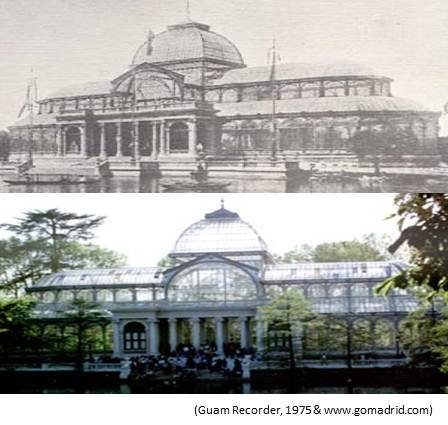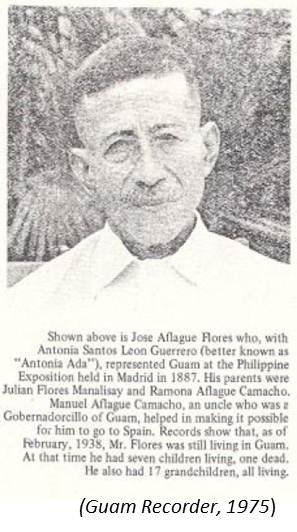In 1887, there was a Philippine Exposition held at the Crystal Palace in the Retiro of Madrid, Spain. Victor Balaguer, Spain’s Colonial Minister, was the brain child of the 1887 Exposition. During this particular time period Spain’s empire was fragile and was eroding. Within the Pacific region, its empire included the Philippines, Mariana Islands and many other Micronesian Islands. Part of the reason for having this exposition was because there was an imminent and growing threat by the Germans who encroached the Western Caroline Islands. Furthermore, some scholars contend that it was also during the 1880’s where Dr. Jose Rizal raised Filipino national consciousness. In addition, the Philippine Exposition was also held with the intent of increasing commercial and economic relation between the archipelago (Philippines, Marianas, Carolinas and Belau Islands) and Spain and would further undermine the trade monopoly of the foreign merchants embedded in the Philippines.

Four people from the Micronesian colonies were sent to the Exposition. Two were from the Caroline Islands. Unfortunately, both had met their fate during the Exposition: Dolores Neisern, 22, and Luis Pe-aripis, age 32, described as married and had a son, and was friendly and of humble disposition despite the contrast of his facial features.
The other two were Chamorros: Antonia Leon Guerrero Santos, also known as Antonian Ada, and Jose Aflague Flores, also known as Chubito. Antonia was described an attractive girl, age 22, simple and kind hearted. She compassionately took care of Dolores Neisern before her passing. Jose was described as an accomplished musician, and was modest and unassuming. The participants of the Exposition were impressed with Jose’s intelligence and wit.

Several artifacts and handcrafted islands from the Mariana Islands were used and sent to the Philippines Exposition. Such items included slingstones, adzes, two bone spearheads, and skeletons found from the Calabera cave, in Sa’ipan. Some photos below were extracted from some of the sources of this article.
Although only two Chamorros were sent, the following people of the Mariana Islands sent various items to Madrid for display during the Exhibition:
|
Name |
From |
|
Aflague, Manuel |
Agana, Guam |
|
Castro, Andres |
Agana, Guam |
|
Castro, Ezequiel |
Agana, Guam |
|
Castro, Juan |
Agana, Guam |
|
Cobo, Francisco |
Agana, Guam |
|
Cruz, Dolores |
Agana, Guam |
|
Cruz, Felipe |
Agana, Guam |
|
Diaz, Joaquin |
Agana, Guam |
|
Dungca, Justo |
Agana, Guam |
|
Fausto, Mariano |
Rota/Sa'ipan/Guam |
|
Flores, Manuel |
Agana, Guam |
|
Guerrero, Vicente L. |
Agana, Guam |
|
Herrero, Ana |
Agana, Guam |
|
Herrero, Vicente |
Agana, Guam |
|
Leon Guerrero, Agapito |
Agana, Guam |
|
Leon Guerrero, Joaquin |
Agana, Guam |
|
Leon Guerrero, Lorenzo |
Agana, Guam |
|
Leon, Joaquin |
Agana, Guam |
|
Martinez, Antonio |
Agana, Guam |
|
Martinez, Juan Crisostomo |
Agana, Guam |
|
Millchamp, Enrique |
Agana, Guam |
|
Munoz, Jose |
Agana, Guam |
|
Pangelinan, Manuel |
Agana, Guam |
|
Perez, Jose |
Agana, Guam |
|
Portusach, Jose |
Agana, Guam |
|
Rodes, Antonio |
Agana, Guam |
|
Sablan, Mariano |
Rota/Sa'ipan |
|
Torres, Felix |
Agana, Guam |
|
Torres, Juan |
Agana, Guam |
|
Tudela, Jose |
Agana, Guam |
|
Salas, Jose |
Agana, Guam |
Sources:
Dale S. Miyagi. 1975. Spanish Micronesia and the Philippine Exposition of 1887, 5 no 1, pp. 31-43. Guam Recorder. Micronesian Area Research Center: Mangilao, Guam.
Luis Angel Sanchez Gomez. 2002. Indigenous Art at the Philippine Exposition of 1887, 14 no. 2, pp 283-294. Journal of the History of Collections. Oxford University Press.
Francisco Garcia Olive. 1887. The Mariana Islands 1884-1887, Random Notes (translated by Marjorie Driver). Micronesian Area Research Center: Mangilao, Guam.

